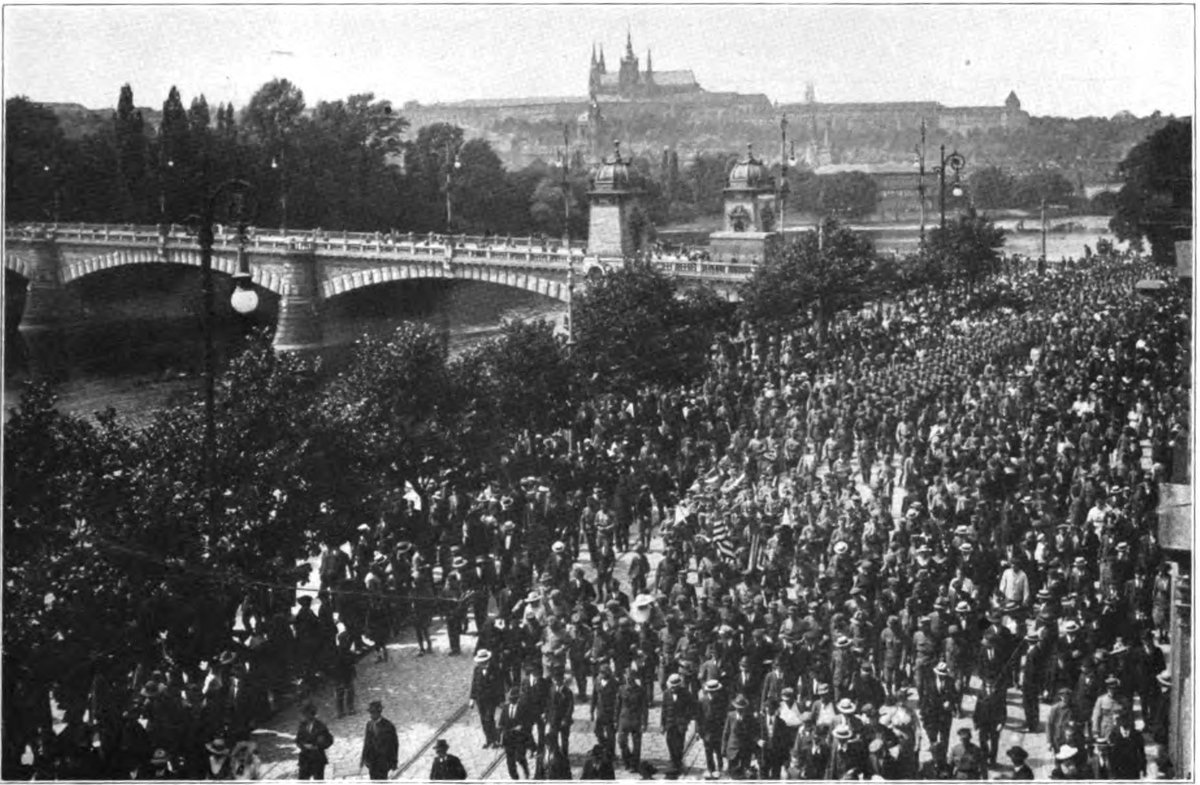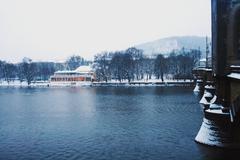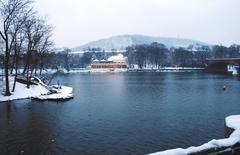
Visiting Brücke der Legionen in Prague: A Comprehensive Guide
Date: 18/07/2024
Introduction
Table of Contents
- Introduction
- Early Beginnings and the Chain Bridge
- The Dawn of the 20th Century and a New Bridge
- The Legacy of the Legions and a New Name
- Enduring Through Time - From World War II to the Present
- Architectural Significance and Symbolism
- Visitor Information
- Nearby Attractions and Points of Interest
- Getting Around
- Dining and Entertainment
- FAQ
- Conclusion
Exploring Legion Bridge - History, Visitor Tips, and Cultural Significance
Early Beginnings and the Chain Bridge
The story of Legion Bridge begins long before its current iteration. In the mid-19th century, the need for a permanent crossing in place of the existing ferries became apparent due to the city’s rapid expansion. This led to the construction of the Franz Joseph Bridge, a chain suspension bridge inaugurated in 1841. This bridge, named after Emperor Franz Joseph I of Austria, marked a significant step in connecting the then-separate towns of Prague and Smíchov.
The Dawn of the 20th Century and a New Bridge
As the 20th century dawned, the Franz Joseph Bridge, while still standing strong, proved inadequate for the burgeoning traffic and heavier loads. The city of Prague decided to replace the aging structure with a more robust and modern bridge. Renowned Czech architect, Antonín Balšánek, known for his work on Prague’s Municipal House, was entrusted with the design.
Balšánek envisioned a grand structure that would not only serve its practical purpose but also enhance the cityscape. He opted for an Art Nouveau design, a popular style at the time, characterized by its decorative elements, flowing lines, and use of modern materials. Construction began in 1900, and after a little over a year, the new bridge, initially named after Emperor Franz Joseph I, was inaugurated in 1901.
The Legacy of the Legions and a New Name
Following the tumultuous events of World War I and the subsequent formation of Czechoslovakia in 1918, the bridge underwent a symbolic renaming. It was dedicated to the Czechoslovak Legions, brave soldiers who fought for the independence of Czechoslovakia during the war. This act served to honor their sacrifice and solidify the bridge’s place in the newly formed nation’s identity.
Enduring Through Time - From World War II to the Present
Legion Bridge, despite its relatively short history compared to Prague’s other bridges, has witnessed significant historical events. During World War II, the bridge, along with other vital infrastructure, was heavily guarded to prevent its destruction by retreating German forces. It survived the war largely unscathed, standing as a symbol of resilience amidst the turmoil.
Following the war and throughout the communist era, Legion Bridge continued to serve as a vital artery of the city. However, it wasn’t until after the Velvet Revolution in 1989 that the bridge received much-needed restoration and maintenance. In the 1990s, extensive renovations were undertaken to restore its former glory, ensuring its continued service for generations to come.
Architectural Significance and Symbolism
Legion Bridge stands out not only for its historical significance but also for its architectural elegance. The Art Nouveau design, with its intricate details and graceful arches, adds a touch of grandeur to the Prague skyline. The bridge’s four iconic obelisks, located at each end, are adorned with bronze sculptures representing allegorical figures, further enhancing its aesthetic appeal.
Beyond its aesthetic beauty, Legion Bridge holds deep symbolic meaning for the people of Prague. It represents the city’s resilience in the face of adversity, its transition from a Habsburg city to an independent nation, and its embrace of modernity while respecting its rich past.
Visitor Information
Visiting Hours and Tickets
Legion Bridge is accessible to the public 24/7 and does not require any tickets for crossing. However, guided tours that include the bridge in their itinerary may have specific schedules and fees.
Travel Tips
- Public Transport: The bridge is easily accessible by tram and bus. The nearest tram stop is Újezd.
- Best Time to Visit: Early morning or late afternoon offers the best light for photography and fewer crowds.
- Nearby Attractions: Don’t miss nearby attractions like Prague Castle, Charles Bridge, and the National Theatre.
Special Events
Legion Bridge often serves as a backdrop for various cultural events and festivals. Check local listings for events during your visit.
Photography Tips
The bridge offers stunning views of the Vltava River and Prague Castle. For the best shots, consider visiting at sunrise or sunset.
Nearby Attractions and Points of Interest
Lesser Town Side
- National Theatre: This grand neo-renaissance building, a symbol of Czech national revival, sits majestically on the banks of the Vltava River, just a stone’s throw from the bridge. Visitors can enjoy opera, ballet, and drama performances or take a guided tour to admire its opulent interiors. (National Theatre)
- Kampa Island: Nestled beneath the bridge, this tranquil island offers a peaceful escape from the city’s bustle. Stroll through its charming park, admire the whimsical sculptures of David Černý, or relax at one of the riverside cafes. (Kampa Island)
- Museum Kampa: Located on Kampa Island, this modern art museum houses an impressive collection of Central European art, including works by Czech Cubist sculptor Otto Gutfreund and František Kupka, a pioneer of abstract art. (Museum Kampa)
- Charles Bridge Museum: A short walk along the Vltava River from Legion Bridge will lead you to the iconic Charles Bridge. The Charles Bridge Museum, housed in the Old Town Bridge Tower, offers a fascinating glimpse into the history and construction of this Prague landmark. (Charles Bridge Museum)
Old Town Side
- Dancing House: This architectural marvel, also known as the “Fred and Ginger” building, stands out with its deconstructivist design. Visitors can enjoy a meal at the rooftop restaurant, offering panoramic city views, or explore the gallery and exhibition space. (Dancing House)
- National Museum: A short walk from the bridge will take you to the imposing neo-renaissance building of the National Museum, housing extensive collections covering natural history, history, arts, and music. (National Museum)
- Wenceslas Square: This bustling square, more of a boulevard, is the commercial and cultural heart of Prague. Lined with shops, restaurants, and historical buildings, it’s a great place to soak up the city’s vibrant atmosphere. (Wenceslas Square)
- Old Town Square: A bit further afield but still within walking distance, the Old Town Square is a must-see for any visitor to Prague. Marvel at the astronomical clock, visit the Tyn Church and the Old Town Hall, or enjoy a horse-drawn carriage ride. (Old Town Square)
Across the River
- Petřín Hill: Take a scenic funicular ride up Petřín Hill, located on the opposite side of the Vltava River, for breathtaking views of Prague. Explore the Petřín Gardens, visit the Petřín Lookout Tower, a miniature replica of the Eiffel Tower, or enjoy a romantic stroll through the rose garden. (Petřín Hill)
- Prague Castle: A UNESCO World Heritage site, Prague Castle is a sprawling complex of palaces, churches, gardens, and historical buildings. Explore the magnificent St. Vitus Cathedral, visit the Old Royal Palace, or stroll through the picturesque Golden Lane. (Prague Castle)
- John Lennon Wall: This colorful wall, covered in John Lennon-inspired graffiti and lyrics, has become a symbol of peace and freedom. Located a short walk from the Charles Bridge on the Lesser Town side, it’s a popular spot for photos and a testament to the power of art and expression. (John Lennon Wall)
Getting Around
Prague is a very walkable city, and most of the attractions mentioned above are within a comfortable walking distance from Legion Bridge. However, the city also offers an efficient and affordable public transportation system, including trams, buses, and the metro. Consider using public transport for longer distances or if you prefer to save your energy for exploring.
Dining and Entertainment
The area surrounding Legion Bridge offers a wide array of dining options, from traditional Czech pubs serving hearty meals to upscale restaurants with international cuisine. You’ll also find numerous cafes, bars, and clubs for a taste of Prague’s vibrant nightlife.
FAQ
Q: Is Legion Bridge accessible for people with disabilities? A: Yes, Legion Bridge is accessible for people with disabilities. There are ramps and smooth pathways for easy navigation.
Q: Are there any guided tours available? A: Yes, several guided tours include Legion Bridge as part of their itinerary. Check with local tour operators for more details.
Q: What are some nearby restaurants? A: There are several cafes and restaurants in the vicinity, offering a range of dining options from traditional Czech cuisine to international dishes.
























































































































































































